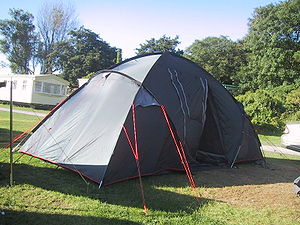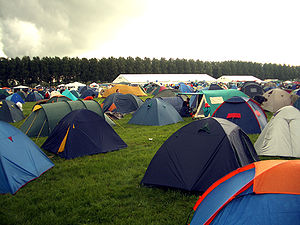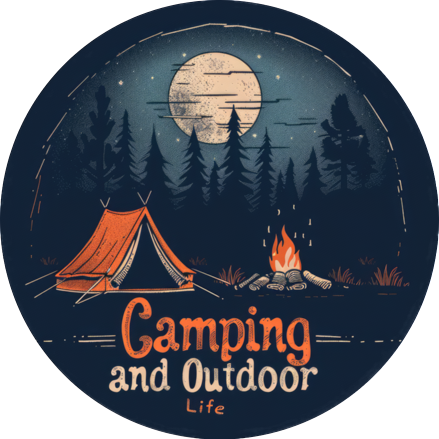When planning a camping trip, one of the most important pieces of gear to consider is a tent. The many types of camping tents on the market range in size, shape, quality, features and price. Several factors should be taken into consideration when deciding which camping tent to buy.
Advantages of Tents

In certain conditions, it is possible to camp without a tent. You may sleep inside a vehicle, or spread out a bedroll on the ground under the stars or maybe a hammock. However, dozing in most cars is uncomfortable, and lying out in the open leaves you vulnerable to weather and wildlife. A tent provides privacy, as well as protection from wind and precipitation. It also contains the heat of those sleeping inside. Driving to a site and pitching a tent is called “car camping.” It differs from “backpacking,” which involves camping along a trail far from a vehicle.
Types of Camping Tents
Tents come in many sizes, from tiny structures designed for single campers to multi-room dwellings for five or more people. The larger ones are heavier, though that is not a vital consideration when pitching a tent near a vehicle. The size can be a factor when packing the car.
There are four basic styles. Hoop tents, also called pup tents, are small and low to the ground. They are intended for one person, who must crawl inside. These tents are small, lightweight, and easy to transport and erect. Because of the tiny interior space, body heat is retained more efficiently than in larger tents.
Dome tents are named for their shape, which features curved sides. They are fairly simple to put up, and come in a variety of sizes to accommodate different numbers of people. Because of their shape, they shed moisture and wind. However, if not properly staked to the ground, they are susceptible to rolling away in strong wind.
Cabin-style tents have straight walls, which provide more interior space than that found in dome tents. Screen tents feature mesh walls for maximum ventilation. While they are often set up for day use, screen tents also are comfortable places to sleep when the weather is hot and the bugs are biting. Just make sure it isn’t going to rain during the night. These tents may be erected over a picnic table and other camp furniture. Family tents are the largest types sold. They sometimes contain more than one room, with multiple doors. The luxury comes at a price, in terms of purchase price and set-up difficulty. Family tents take a lot of space, which can be an issue in some campgrounds.
Many tents have features for different seasons of the year. Summer, or two-season, tents are lightweight and easy to erect. They have several large, screened windows and a mesh door to allow air to circulate and keep the interior cool. A three-season tent, intended for all times of year except winter, is a bit heavier and and more durable. It is built to withstand rain and snow, with a rain fly designed to divert water away from the tent. A four-season tent has aluminum poles and other features that make it sturdier than the others. It is also heavier and provides less ventilation.
Tents are generally made of nylon or polyester. Nylon is lighter and stronger, and repels moisture effectively. However, it deterioriates with exposure to the sun faster than a polyester tent.
Choosing a Tent
The cost of a tent ranges from as little as $50 to more than $1,000. The size of the structure and the quality of materials are the major factors in determining the price. Buyers should consider their budgets, as well as how much they plan to use their tents.

Those intending to camp frequently, or for a long period, may want more durable tents. This is also a good idea for families with young children or pets. As already noted, nylon is stronger than polyester. Aluminum poles are much less likely to break than fiberglass types, which can be an important factor in extremely windy conditions.
More expensive tents have better zippers that last longer than those in cheap tents. Round zippers, like those around some tent doors, are more likely to break than zippers that are pulled in a straight line. Rubbing a bar of soap on a zipper helps keep it in working order.
Inexpensive tents may have poorly sealed seams, so it’s a good idea to buy a bottle of seam sealer. The goal is to keep moisture from seeping into the tent. Better tents usually come with metal, rather than plastic, stakes. A lightweight stake may work fine in sand or soft soil, but is nearly worthless on hard or rocky ground.
The rain fly on a cheap tent likely covers only the top of the structure. A more effective rain fly is one that stretches from the top to the bottom of the tent, attaching to the stakes. This design better protects the tent from precipitation and wind. It is recommended when rain or snow is forecast. Some tents feature vestibules, small rooms just outside the door, which provide a space to shed wet clothing and boots. Vestibules also trap cold air, helping to keep the main tent space warm. Another special feature, an awning, may be set up outside the door to prevent moisture from getting inside.
The proper choice depends upon your budget, the amount of time you plan to spend camping, weather conditions, the size of your family, personal comfort considerations and other factors. Getting a good camping tent that is right for you is one of the keys to an enjoyable, memorable outdoor adventure.







[…] Camping Tents […]